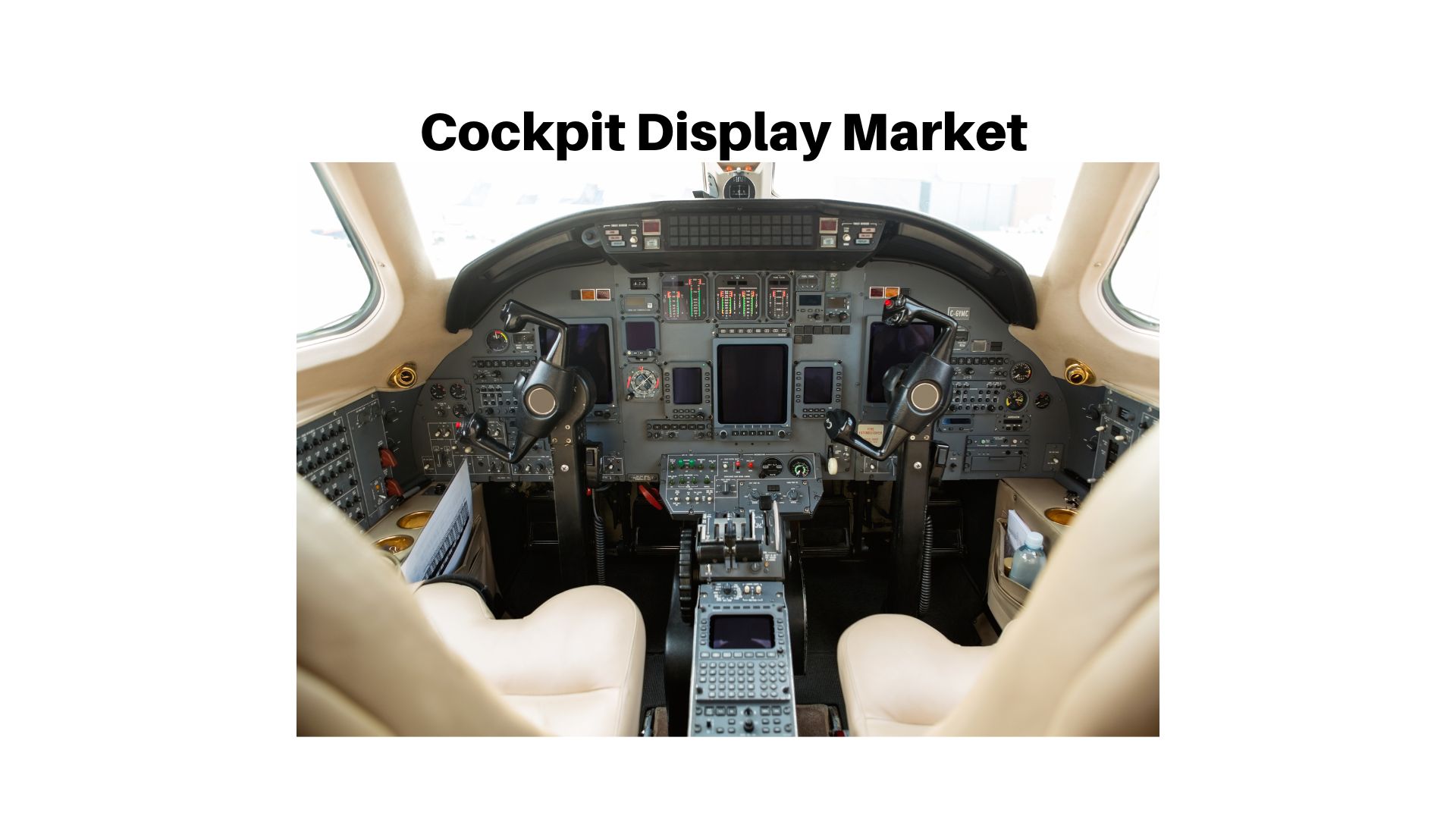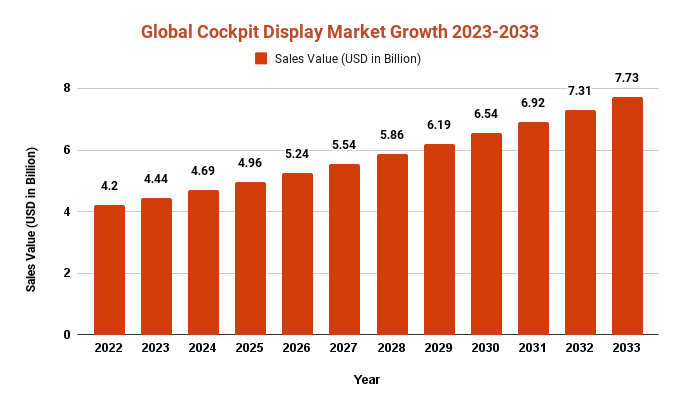Cockpit Display Market Size is expected to reach USD 7.73 Bn by 2033

Page Contents
Market Overview
Published Via 11Press: Global Cockpit displays Market provide aircraft pilots with key information. Cockpit displays have evolved significantly over time, as newer technologies provide even more advanced capabilities and features. There are various cockpit displays, such as primary flight displays (PFDs), multifunction displays (MFDs), electronic flight instrument systems (EFISs), and head-up displays (HUDs).
The Cockpit Display Market size is expected to reach USD 7.73 Bn by 2033, up from its current value of USD 4.2 Bn in 2022, growing at an annual compound growth rate (CAGR) of 5.7% from 2023-2033.
Overview of Types:
- Primary Flight Displays (PFDs): PFDs provide pilots with vital flight data such as altitude, airspeed, vertical speed, heading and attitude. These displays typically sit in the center of an instrument panel and serve as one of the primary means of providing vital flight data.
- Multifunction Displays (MFDs): MFDs provide additional information to pilots such as weather data, navigation details and system status updates. They are often installed along the sides of an instrument panel.
- Electronic Flight Instrument Systems (EFIS): An Electronic Flight Instrument System is an advanced digital system that integrates information from various sensors into one comprehensive display in the cockpit. Pilots using an EFIS have access to more comprehensive views of their aircraft's status than when using traditional mechanical instruments alone.
- Head-Up Displays (HUDs): HUDs present vital flight data onto a transparent screen in front of a pilot's line of sight, enabling them to keep their eyes focused on what lies outside while still having access to critical flight info.
Key Takeaways
- Cockpit displays provide pilots with crucial flight data such as altitude, airspeed, vertical speed, heading and attitude.
- Cockpit displays come in various forms, from primary flight displays (PFDs), multifunction displays (MFDs), electronic flight instrument systems (EFISs), and head-up displays (HUDs).
- PFDs are essential pieces of cockpit hardware and provide pilots with essential flight information.
- MFDs provide additional information such as weather updates, navigation data and system status.
- An EFIS is a digital system that integrates information from various sensors into cockpit displays for greater pilot oversight of aircraft status.
- HUDs provide pilots with critical flight data via an LCD or transparent screen in front of their line of sight, enabling them to keep their eyes focused on what lies outside while still having access to essential flight data.
- Cockpit displays are essential tools that allow pilots to operate an aircraft safely and efficiently. Over the years, cockpit displays have grown increasingly more sophisticated with each new technology offering additional capabilities and features.
As technology progresses, cockpit displays may become even more powerful and capable in the coming years.

Request Sample Copy of Cockpit Display Market Report at: https://marketresearch.biz/report/cockpit-display-market/request-sample/
Regional Snapshot
Development and implementation of cockpit displays vary across regions depending on factors like regulations, technology availability and the aviation industry needs of that region. Here is a snapshot of regional cockpit displays:
- North America: North America has long been at the forefront of creating and implementing advanced cockpit display systems. The region has taken the lead in adopting cutting-edge technologies such as synthetic vision systems (SVS), advanced weather radar, and improved situational awareness tools.
- Europe: Europe places great emphasis on safety, with stringent regulations for cockpit display systems. Europe was an early adopter of head-up displays (HUDs) and electronic flight bags (EFBs) into cockpits.
- Asia Pacific: Asia Pacific has seen tremendous expansion of aviation industry over recent years, and cockpit displays are integral components. To maintain safety and operational efficiency, many countries in this region have invested in advanced cockpit display systems for better aircraft cockpit displays.
- Middle East and Africa: These regions are experiencing impressive aviation industry expansion, and cockpit displays are becoming more important as aircraft pilots adopt cutting-edge technologies, like HUDs and EFIS systems, to improve safety and efficiency.
Any inquiry, Speak to our expert at: https://marketresearch.biz/report/cockpit-display-market/#inquiry
Drivers
- Safety: Safety is at the core of cockpit displays development. Cockpit displays provide pilots with vital information that aids them in making informed decisions during flight, while using advanced technologies like synthetic vision systems and situational awareness tools can reduce accident risks while increasing overall flight safety.
- Efficiency: Cockpit displays can enhance flight operations efficiency by giving pilots real-time information on aircraft performance and fuel usage, helping them make informed decisions that make better use of resources while decreasing costs.
- Regulations: Aviation regulators around the world have implemented stringent requirements for cockpit displays in order to enhance flight safety. Airlines operating within certain regions must abide by these regulations, prompting their adoption of advanced cockpit display systems.
- Technological Advancements: Technological advancements such as high-resolution displays, advanced processors and new software applications have allowed for the creation of more capable cockpit display systems.
- Customers' Needs: Airlines and aircraft manufacturers are increasingly focused on creating an enjoyable flying experience for passengers. Cockpit displays can play an essential role here by giving pilots all of the tools necessary for operating flights safely and efficiently.
Restraints
Cockpit display systems can be expensive, and this often poses as a significant barrier for their development and implementation. Advanced technologies, like synthetic vision systems and head-up displays can be particularly pricey, making it challenging for smaller airlines and aircraft operators to adopt these systems.
- Compatibility: Cockpit displays must be compatible with existing aircraft systems and infrastructure, which may present significant difficulties on older aircraft or those using obsolete technology.
- Certification: Before Cockpit display systems can be implemented in aircraft, they must pass stringent certification requirements that may take several months and cost thousands of dollars – delaying their deployment and potentially delaying adoption of innovative technologies.
- Training: Pilots need to receive adequate instruction on how to utilize new cockpit display systems effectively, which may prove challenging when these new technologies differ greatly from existing technologies.
- Regulation Restrictions: Regulations can impede the creation and implementation of cockpit display systems. Each region has different regulations pertaining to cockpit displays, making it challenging for airlines to offer global service with one set of technologies.
Opportunities
Advanced cockpit display systems such as synthetic vision systems and enhanced situational awareness tools can greatly enhance flight safety by providing pilots with necessary information during flight.
- Enhance operational efficiency: Cockpit displays provide pilots with real-time information about an aircraft's performance and fuel consumption, helping them make informed decisions that optimize resource use while cutting costs.
- Enhance passenger experience: Cockpit displays can enhance passenger experiences by decreasing flight disruptions and streamlining operations more efficiently.
- Reduced environmental Impact: Cockpit displays can help mitigate the environmental impact of air travel by improving flight operations efficiency, decreasing fuel usage and minimizing its carbon footprint per flight.
- Innovation and technological development: The creation and installation of advanced cockpit display systems requires considerable technological innovation and advancement, providing opportunities for the aviation industry to drive further advancement of technology.
Challenges
- Data Overload: Cockpit displays can present pilots with an overwhelming amount of information that may become overwhelming and cause information overload, leading them to miss critical details or make poor decisions. This could cause pilots to miss key information or make inaccurate judgment calls that result in missed critical details or incorrect decisions being made.
- Compatibility with Existing Systems: Cockpit displays must be compatible with existing aircraft systems and infrastructure, which may pose a considerable challenge when working on older planes with outdated technology.
- Training: Pilots require training on how to effectively utilize new cockpit display systems. This may prove daunting when dealing with complicated or vastly different technologies than existing technologies.
- Cybersecurity: Cockpit displays are connected to various systems and networks, leaving them susceptible to cybersecurity attacks. This poses a substantial challenge to the aviation industry as breaches can create serious safety and operational risks.
- Regulation: Cockpit display system development can present its own set of challenges when it comes to regulations. Different regions often have differing requirements for cockpit displays, making it more challenging for airlines to operate globally with a uniform set of technologies.
Market Segmentation
Size
- Below 5 Inches
- Between 5 and 10 Inches
- Above 10 Inches
Vehicle
- Automotive
- Tactical Vehicles
- Trains
- Others
Key Players
- Continental AG
- AU Optronics Corp.
- Japan Display Inc.
- Garmin Ltd.
- Innolux Corp.
- Texas Instruments Inc.
- Rockwell Collins Inc.
- Alpine Electronics Inc.
- General Dynamics Canada Ltd.
- Esterline Technologies Corp.
Report Scope
| Report Attribute | Details |
| Market size value in 2022 | USD 4.2 Bn |
| Revenue forecast by 2033 | USD 7.73 Bn |
| Growth Rate | CAGR Of 5.7% |
| Regions Covered | North America, Europe, Asia Pacific, Latin America, and Middle East & Africa, and Rest of the World |
| Historical Years | 2017-2022 |
| Base Year | 2022 |
| Estimated Year | 2023 |
| Short-Term Projection Year | 2028 |
| Long-Term Projected Year | 2033 |
Request Customization Of The Report: https://marketresearch.biz/report/cockpit-display-market/#request-for-customization
Recent Developments
Recent advances in cockpit display systems have focused on improving pilot situational awareness. New systems use sophisticated graphics and displays to provide real-time information on aircraft position, flight path, weather conditions and other vital data that pilots need for effective flight operations.
- Head-Up Displays (HUDs): Head-up displays have long been in use, yet recent innovations have focused on further improving their accuracy and reliability. Modern HUDs employ cutting-edge technology to deliver real-time data directly in line of sight for pilots so as to reduce any need to look away from the flight path.
- Synthetic Vision Systems: Synthetic vision systems (SVSs) use 3D terrain mapping technology and other innovations to provide pilots with an enhanced view of their surrounding terrain. Recent innovations in SVS technology have focused on increasing accuracy and reliability, making this essential tool for pilots.
- Touchscreen displays: Touchscreen displays have become an increasingly popular option in cockpit display systems, enabling pilots to interact with them using intuitive gestures and touch-based commands. Recent developments in touchscreen technology have focused on improving accuracy while decreasing latency to provide pilots with a more responsive and reliable interface.
- Connectivity: Modern cockpit display systems are increasingly linked to external networks and systems, enabling pilots to gain access to real-time data while communicating with ground-based systems. Recent advancements in connectivity technology have focused on increasing reliability and security; assuring cockpit display systems remain safe.
Key Questions
What Is a Cockpit Display System (CPDS)?
A cockpit display system (CPDS) is an electronic set of displays used to provide pilots with important flight-related information during flight, such as aircraft performance, position and navigation data as well as weather and environmental factors.
What are the advantages of cockpit display systems?
Cockpit display systems offer numerous benefits to aircraft operators and passengers alike, including improved flight safety, increased operational efficiencies, enhanced passenger experiences, reduced environmental impacts, as well as opportunities for innovation and technological advancement.
What are the challenges associated with cockpit display systems?
Cockpit display systems present many obstacles, such as data overload, compatibility issues between different systems, training requirements, cybersecurity needs, and regulation issues.
How Can Cockpit Display Systems Affect Flight Safety?
Cockpit display systems enhance flight safety by providing pilots with real-time information regarding an aircraft's performance, position and environment – this information allows pilots to make informed decisions, recognize any potential hazards quickly, and respond swiftly when events arise during flight.
Contact us
Contact Person: Mr. Lawrence John
Marketresearch.Biz (Powered By Prudour Pvt. Ltd.)
Tel: +1 (347) 796-4335
Send Email: [email protected]
The team behind market.us, marketresearch.biz, market.biz and more. Our purpose is to keep our customers ahead of the game with regard to the markets. They may fluctuate up or down, but we will help you to stay ahead of the curve in these market fluctuations. Our consistent growth and ability to deliver in-depth analyses and market insight has engaged genuine market players. They have faith in us to offer the data and information they require to make balanced and decisive marketing decisions.


